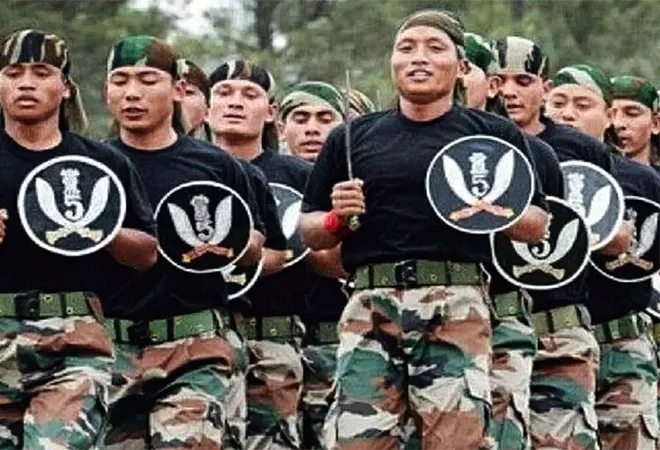
The recent announcement of inducting Nepali youth into the Indian Army’s Agneepath scheme has been creating ripples across the open border. Even though Nepal has not yet agreed to include its youth in the Gorkha regiment, New Delhi has
already set up Gorkha Recruitment Depots (GRD) at Darjeeling (West Bengal) and Gorakhpur (Uttar Pradesh). Additionally, preliminary
tests have also been scheduled in Butwal (25 August ) and Dharan (1 September ), in Nepal, thereby creating a more complex situation. Nepal has clearly stated that the Indian government has not taken this decision in liaison with the Nepali counterpart, since the admissions got stalled due to the COVID-19 pandemic.
The Agneepath Scheme and the Gorkha regiment
The Agneepath scheme has been
regarded by the Defence Minister of India, Rajnath Singh, as a ‘transformative reform to enhance the combat potential of the Armed Forces with a younger profile and technologically-adept soldiers’. Forty-six thousand youth within the age group of 17.5–21 years, known as ‘Agniveers’ (
constituting a 12-lakh strong army by 2032-33), will be a part of this
profile. The participants shall also be made a part of the civil society, contributing towards nation-building and would receive aid worth 11.7 lakhs under the Seva Nidhi
scheme of the government, meant for young people from financially deprived ranks of society. Moreover, up to 25 percent of the cadres from each batch will be enrolled as regular rank holders in the Indian Army after the tenure of preparation is over.
The participants shall also be made a part of the civil society, contributing towards nation-building and would receive aid worth 11.7 lakhs under the Seva Nidhi scheme of the government, meant for young people from financially deprived ranks of society.
Within this framework, the aim of recruiting young Nepalis in the Indian Army’s seven Gorkha regiments—which make up 43 battalions—has been advanced by the Indian government.
Interestingly, the Nepali Gorkhas have been a part of the Indian and British armies since the Tripartite Agreement of 1947 was signed between India, Nepal, and the UK. However, with the shrinking size of the British Army, the Gorkha regiment has been absorbed into an amalgamated Royal Gorkha Rifles, which also does not allow residency in the country for those who have retired after 1997. The situation is not the same in India, where retirees from this regiment can settle anywhere in the country. The Indian government had also been sympathetic towards those Gorkha veterans who often claimed backlash from the Nepal government over their non-entry in mainstream Nepali politics, also reflected through the erstwhile Maoist demands
of doing away with such a Gorkha regiment in India.
One of the primary reasons for this detachment was an apprehension from the Nepalese side that they might be
treated as mere mercenary forces. The anti-recruitment lobby in the country has been staging its dismay of forwarding Nepali nationals to be a part of a foreign country, despite the geographical proximity. In 2012, the government of Baburam Bhattarai in Nepal attempted to put an end to any such further enlistment in the Indian Army. Unfortunately, this measure was not successful because of public outcry that supported this framework as a form of drawing a lucrative salary, while their own country Nepal was not able to match up. Having said that, everything was not copacetic as it appeared to be when more than 1,600
ex-Indian Army personnel, especially the Nepali nationals who were a part of the Gorkha regiment, were not able to draw a pension in 2020. Even though the reason was the pandemic, nonetheless there was disappointment regarding the flawed structure that was prevailing across the border. This situation has likely contributed to the disinterest shown by Nepal towards the Agneepath scheme. Nepal has been very clear that it was
not consulted by the Indian government before the Himalayan nation was even approached to sign up officially. Moreover, this will also have a direct impact on the salaries of 35,000 Gorkhas and the pension of 1.35 lakh ex-servicemen (ESM) which amount to around US$ 620 million. As Nepal has a defence budget of US$ 430 million, it will be a huge blow to Nepal’s economy and would add to the growing job insecurities.
Nepal has been very clear that it was not consulted by the Indian government before the Himalayan nation was even approached to sign up officially.
Even in India, the radical change in recruitment saw widespread criticism. It was
argued that this project will “dilute professionalism, military ethos and fighting spirit” as there was no pilot project to put the idea to test. Moreover, it might render 35,000 combat-trained youth jobless as there would be no guarantee of a job for everyone. To add to this, India has to factor in the Nepali youth’s expectations from such a programme.
Already 34,000 Nepali youth are posted in the Indian Army’s Gorkha Regiment. With the induction of 1,300 more through the Agneepath scheme, whether the Nepali section will make it into the final 25 percent is a question that would remain unanswered.
Factoring in China
Apart from this, Nepal also has been receiving its fair share of
military assistance from China, such as the NPR 2.5 billion (RMB 150 million) pledge in 2018 for building a new kind of security partnership—a point that it has been keeping in mind while assessing the Agneepath. China has been maintaining a very good rapport with Nepal for a long time,
mainly to keep in check the Tibetan separatists. As recently as 2020, the Defense Minister of China visited Nepal to bolster deeper military ties between the two countries. This was the
same time when Indian Army Chief, M. M Narvane had visited the Kathmandu Valley, right after the
political map row between the two neighbours, over Kalapani, Limpiyadhura and Lipulekh. Both India and China were also parts of the national defence force of Nepal’s government to government call for
supplying medical items during the COVID crisis.
Nepal also has been receiving its fair share of military assistance from China, such as the NPR 2.5 billion (RMB 150 million) pledge in 2018 for building a new kind of security partnership—a point that it has been keeping in mind while assessing the Agneepath.
Thus, this tug of war has always been omnipresent for the last five years, directly affecting Nepal’s participation in the military in conjunction with India, since the picture is more complicated than it seems to be. If Nepal can receive its due compliment in the Indian Army then the Agneepath offer would be a beneficial one, especially for employment generation and the beginning of a new chapter in the Gorkha Regiment of the Indian Army—a much sought-after cluster that has had its share of gallantry and commitment. What Nepal needs to keep in mind is the art of balancing the strategic cards since it has been receiving similar sources of benefit from other ends too. As a landlocked nation, it would be beneficial for Nepal to remain in the good books of both—and vice versa in both countries—with amicability and greater functionality of its resources.
The views expressed above belong to the author(s). ORF research and analyses now available on Telegram! Click here to access our curated content — blogs, longforms and interviews.



 The recent announcement of inducting Nepali youth into the Indian Army’s Agneepath scheme has been creating ripples across the open border. Even though Nepal has not yet agreed to include its youth in the Gorkha regiment, New Delhi has
The recent announcement of inducting Nepali youth into the Indian Army’s Agneepath scheme has been creating ripples across the open border. Even though Nepal has not yet agreed to include its youth in the Gorkha regiment, New Delhi has  PREV
PREV


